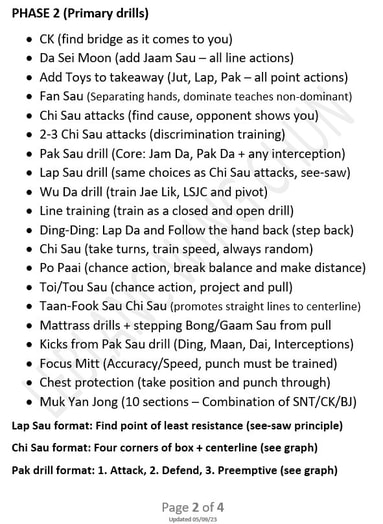PHASE TWO

Phase Two further develops and then brings together the elements of Phase One into working reflex drills. Wing Chun characteristically teaches in a modular fashion (small ideas progressively linked together), building and combining component pieces, and concepts until finally arriving at Chi Sau, the soul of Wing Chun.
Phase Two ends with instruction in the entire Wing Chun dummy training, aka the Muk Yan Jong. Dummy training is often misunderstood as arm and hand conditioning, in our lineage the emphasis is on the reinforcement of attributes, structure and skills, with an focus on what is usually called recovery.
The Dummy, like 3rd hand form Biu Ji, is primarily focused on building habits to recover or compensate from mistakes and circumstances that are not ideal but must be addressed to either continue or to escape. Wing Chun devotes a percentage of its training on when things do not go our way; this is a commentary on the fact that we are all fallible and preparation for mistakes of even failure, and then a viable retreat, is necessary for a complete presentation.
Phase Two ends with instruction in the entire Wing Chun dummy training, aka the Muk Yan Jong. Dummy training is often misunderstood as arm and hand conditioning, in our lineage the emphasis is on the reinforcement of attributes, structure and skills, with an focus on what is usually called recovery.
The Dummy, like 3rd hand form Biu Ji, is primarily focused on building habits to recover or compensate from mistakes and circumstances that are not ideal but must be addressed to either continue or to escape. Wing Chun devotes a percentage of its training on when things do not go our way; this is a commentary on the fact that we are all fallible and preparation for mistakes of even failure, and then a viable retreat, is necessary for a complete presentation.
